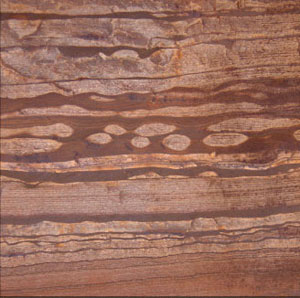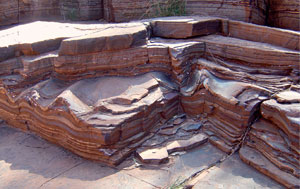
CARLOS ALBERTO ROSIERE / UFMGDeposits of oxidized iron, in detailCARLOS ALBERTO ROSIERE / UFMG
Who does not like the Earth? It is by far away the most hospitable place in the solar system. Uncountable life forms of incredible complexity occupy each small corner of the globe, from the depths of the sea to the top of the highest mountains. Biological variety – the famous biodiversity – is one of the most captivating aspects of the planet. However, this is not the way it has always been. There was a time – most of the time, in fact – when all that there was on the face of the Earth were simple, single cell beings: bacteria.
The diversity of species only began to increase after a radical event changed the equation of terrestrial life and drastically raised the habitability of our world, allowing us, ultimately, to exist. That event was the raising of oxygen levels in the atmosphere, which has left records in very ancient rocks. An international research group, in which a Brazilian participated, analyzed samples of these rocks from different regions on the planet and has now obtained strong indications of when and how this transformation, which made the oxygen levels go from undetectable in the primitive atmosphere to the 20% found in the current atmosphere, happened.
It is believed that it was life itself that gave rise to all this oxygen and promoted a change in the composition of the Earth’s atmosphere. According to paleontologists, this alteration started when the capacity to carry out photosynthesis emerged during the evolution of living beings. Commonly associated with plants, the ability to produce oxygen is also common to bacteria, such as the blue algae, single cell beings that live in the oceans and that, despite their name, are more like bacteria than algae. The great virtue of photosynthesis is that it converts sunlight and carbon dioxide into energy for metabolism. Oxygen is released as a by-product.
It was not easy, however, to introduce the gas in great quantities into the atmosphere. For a long time the composition of the air remained basically the same because oxygen, which is highly reactive, quickly interacted with other substances present in the sea, oxidizing them. The main target was the iron coming from the rocks and that had been dissolved in water. The result was the precipitation of oxidized iron, which was deposited on the ocean floor. Therefore, there was practically no oxygen left for the atmosphere. Only when all the potential for oxidation had been exhausted – rocks and the ocean no longer had any way of absorbing the oxygen- did this gas finally begin to accumulate in the air.
It was precisely in iron-bearing formations spread throughout the world that the researchers, led by Kurt Konhauser and Stefan Lalonde, from the University of Alberta, in Canada, found clues for telling this whole story. In an article published in October in Nature, the British scientific periodical, they managed to establish a date for the transition from the ancient atmosphere to the new: oxygen started accumulating in the air 2.48 billion years ago – the Earth today is around 4.6 billion years old – and it was relatively quick.
To determine how and when this change occurred, the researchers analyzed the distribution of the chemical element chromium (Cr) and its isotopes in iron-bearing formations. The idea is that the distribution of this and other chemical elements in rocks hold clues to the characteristics of the oceans with which these elements had contact in ancient times.
On the trail of chromium
The researchers looked worldwide for rock samples that were rich in iron – including in the Iron Quadrilateral region of the state of Minas Gerais. The person chosen to collect and analyze the Brazilian material was geologist Carlos Alberto Rosière, from the Federal University of Minas Gerais (UFMG).

CARLOS ALBERTO ROSIERE / UFMGRock formations in AustraliaCARLOS ALBERTO ROSIERE / UFMG
As the rocks were of different ages it was possible to infer changes in the atmosphere and ocean environment over time. It was concluded that some 2.5 billion years ago large quantities of chromium were extracted from these rocks and transported from the continent to the ocean by extremely acidic surface waters, containing sulfuric acid, produced from the decomposition of pyrite (iron sulfate). As these reactions in the rocks are mainly explained by the presence of acidophilic aerobic bacteria – which need oxygen from the air to live and are capable of surviving in acidic environments – it is supposed that a significant quantity of oxygen had already accumulated in the atmosphere of the planet.
There is evidence, however, that the production of this gas started long before, around 3.5 billion years ago, with the blue algae, also known as cyanobacteria. For a long time, however, the oxygen released by these algae hardly reached the atmosphere because it quickly interacted with the iron of volcanic origin that was dissolved in the sea, giving rise to the great iron-bearing formations now found on the continents and that supply mining companies and the steel industry. “After this initial oxygen production phase, which lasted almost 1 billion years, the transformation process of the atmosphere may have been very fast,” says Rosière. “In 100 -200 million years it already had large amounts of oxygen.”
These signs that an atmosphere rich in oxygen already existed 2.5 billion years ago are the most ancient so far identified. Moreover, they are compatible with previous analyses based on other evidence of this important event in the history of the Earth, called the great oxygenation event. However, the researchers admit that acceptance of these conclusions is not general. “Some may say that the characteristics we found in the iron-bearing formations indicate local conditions, but not those of the entire planet,” explains Rosière.
Only more evidence will enable the researchers to confirm that this is a sign of the episode that allowed the eventual rise of multicell creatures, such as large animals and human beings. “In geology, one or two swallows don’t make a summer. There’s a large amount of data that can be questioned or interpreted in an alternative way. So it’s necessary to have a sum of data that converges in a given direction,” says Rosière. “We can’t say: now we’re satisfied; matters have been solved.”
Scientific article
KONHAUSER, K.O. et al. Aerobic bacterial pyrite oxidation and acid rock drainage during the Great Oxidation Event. Nature. 19 Oct. 2011.